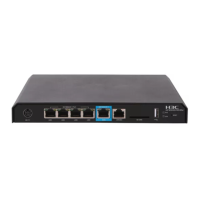24
• Changing port priority—If no packet priority is trusted, the port priority of the incoming port is
used. By changing the port priority of a port, you change the priority of the incoming packets on
the port.
To configure priority mapping, perform the following tasks:
(Optional.) Configuring a priority map
(Required.) Perform one of the following tasks:
• Configuring a port to trust packet priority for priority mapping
• Changing the port priority of an interface
Configuring a priority map
The device provides the following types of priority map:
dot11e-lp 802.11e-local priority map.
dot1p-lp 802.1p-local priority map.
dscp-lp DSCP-local priority map.
lp-dot11e Local-802.11e priority map.
lp-dot1p Local-802.1p priority map.
lp-dscp Local-DSCP priority map.
To c onfigure a priority map
1. Enter system view.
system-view
N/A
2. Enter priority map
view.
qos map-table
{
dot11e-lp
|
dot1p-lp
|
dscp-lp
|
lp-dot11e
|
lp-dot1p
|
lp-dscp
}
N/A
3. Configure
mappings for the
priority map.
import
import-value-list
export
export-value
By default, the default priority
maps are used. For more
information, see "Appendixes."
Newly configured mappings
overwrite the old ones.
Configuring a port to trust packet priority for
priority mapping
You can configure the device to trust a particular priority field carried in packets for priority mapping
on ports or globally.
When you configure the trusted packet priority type on an i nterface, use the following available
keywords:
• dot1p—Uses the 802.1p priority of received packets for mapping.
• dscp—Uses the DSCP precedence of received IP packets for mapping.

